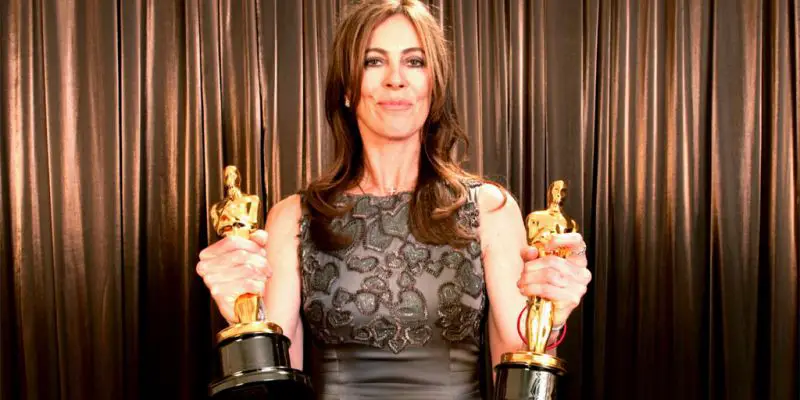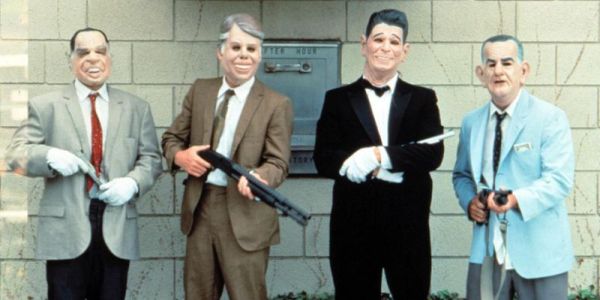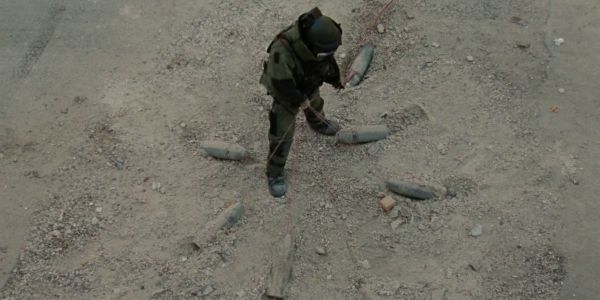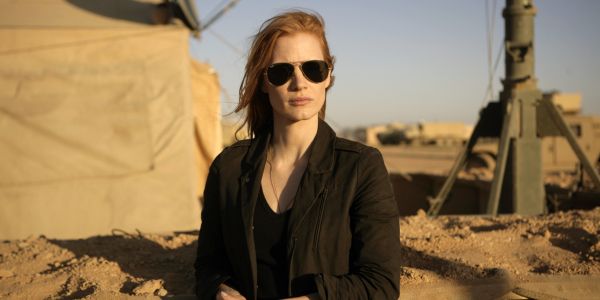The Beginner’s Guide: Kathryn Bigelow, Director

Lauren has worked in the entertainment industry in Los Angeles…
If people know one thing about Kathryn Bigelow, hopefully it is the fact that she became the first woman to win an Academy Award for directing The Hurt Locker. But the reality may be people know her because she directed Point Break or was married to director James Cameron.
Most of her career, she has been pegged as a female action director, a label which diminished her influence and films. Bigelow has a background in the art world: she grew up painting, attended the San Francisco Art Institute and then received entry into the Whitney Museum’s Independent Study Program, where she lived and studied in New York where her advisors were the likes of Susan Sontag and Lawrence Weiner.
She worked with both Weiner and artist Vito Acconci on performance and video art pieces and became more interested in film.
Her first short film, The Set-Up (1978) features two men fighting each other in an alley. Bigelow ran out of money to finish the film and sent it to Columbia University, where it became her entry into the graduate program in film. She graduated in 1981 with a master’s in film theory. Although Bigelow left the art world years ago, much of her work is couched in theories from her time as an artist and later, an academic. She speaks about subjects such as found art, semiotics, and fascism in interviews, yet she has truly made her films accessible and available.
Watching her nine-film filmography in its entirety allows you to see her visual skills and how those skills finally find their verbal match during her recent films. But if you’re looking for highlights, here’s where to start.
Utah, Get Me Two
If you’ve never seen Point Break (1991) before, well, you probably need to watch Point Break.
Point Break is an adrenaline-filled ride into the world of bank robbers and surf culture. Keanu Reeves plays FBI agent Johnny Utah, a former Ohio State quarterback, who is tasked with infiltrating a group of surfers (led by Patrick Swayze) who are suspected of being a ring of bank robbers called the Ex-Presidents because they commit crimes in masks of Reagan, Carter, Nixon, and Johnson masks.

Yes, it all sounds pretty ridiculous on paper, but the way Bigelow uses the camera to capture the movement of surfing, skydiving, and police foot chases is truly intoxicating. In between all of the testosterone-fueled action sequences, she manages to capture the intimate, quiet moments.
The action is enticing to males, but Bigelow sneakily flips the script – or in her case, the camera – on the male gaze concept, a common, recurring theme in her films. At the beginning of the film, Bigelow captures Bodhi riding waves in a tight bodysuit and then the scene switches to Utah navigating an FBI training course in the rain, his t-shirt soaked and clinging to his body. Normally, we would be seeing these shots of female bodies, viewed from the male lead’s point of view, but Bigelow pokes a little fun at that cinematic concept, while still remaining deeply rooted in a male world.
Although the film is over the top, Bigelow is always beneath the surface, taking her subject matter seriously as she plays with film form and explores deeper themes.
A Vampire Western?
Backing up, the next film on your list should be her 1985 film, Near Dark. Although it is referred to as a vampire film, the term is never used in the movie, and the typical ideology is stripped away: no coffins, wooden stakes, or garlic. Caleb (Adrian Pasdar), a normal farm boy, encounters Mae (Jenny Wright) at the local ice cream parlor one evening. Mae drops plenty of hints that she’s not who he thinks she is, but Caleb doesn’t take the bait, and soon finds himself bitten and forced to join Mae’s band of drifters, who include Jesse (Lance Henriksen) and Severen (Bill Paxton).
In this band of misfits running from the daylight, we come across another of Bigelow’s themes. Her films often depict a group of outsiders with a shared mission. And in Caleb we find a play on gender roles. He is the innocent victim, the role so often played by young women in horror films. He is the prey, the one who is bitten by Mae, who is cast in the role of the aggressor.
While Point Break is, as Bodhi says, 100% pure adrenaline, Near Dark shows the darker, unapologetic intensity that Bigelow has for violence. There’s a scene about halfway through the film where the gang takes over a local bar and kills all of the people inside in order to feed off of their blood. Even lightened by humor, the scene is dark and grisly, and it’s Bigelow showing us she’s not afraid to push boundaries.
9/11 Series
Bigelow’s most recent films, The Hurt Locker and Zero Dark Thirty, are actually at the top of my must see list, but in order to see just how wonderful these films are, it’s important to watch some of Bigelow’s early work first for comparison.
After directing K-19: The Widowmaker, a real life story, Bigelow was interested in doing more topical work and she was introduced to Mark Boal‘s journalism. His stories explore topics that aren’t exactly feel good entertainment – the war in Iraq, the war on terror, the war on drugs – but which are important and interesting and happen to fit perfectly with Bigelow’s interest in intense stories and exceptional events.

The Hurt Locker examines a day (or days) in the life of an Explosive Ordinance Device team during the U.S. war in Iraq. EODs, in Iraq, most often meant roadside bombs, and the film depicts how the war in Iraq was so different from past wars Americans had fought: there was no battlefield in Iraq, it was a war of the insurgency, and you could be attacked from any direction.
When the EOD team made up of Sergeant JT Sanborn (Anthony Mackie) and Specialist Owen Eldridge (Brian Geraghty) loses a team leader, Sergeant First Class William James (Jeremy Renner) comes aboard. A bit of a renegade, James has trouble working with Sanborn and Eldridge, and seems to get off on the risk. But again, Bigelow’s quiet moments find us and we begin to realize how damaged James really is.
The film has a documentary feel which really puts you on the ground in the middle of the action. If your hands don’t sweat the first time you see this film, you’re watching it wrong.
Bigelow followed up The Hurt Locker, which won her Academy Awards for Best Directing and Best Picture, as well as Best Screenplay for Boal, with another war time film, Zero Dark Thirty. Zero Dark Thirty is about the manhunt for Osama bin Laden by the CIA. As the war on terror stretches over years, the focus of the team becomes preventing another attack on American homeland, but Maya (Jessica Chastain) perseveres with a religious fervor in her mission to find bin Laden.

The film was criticized for its portrayal of torture, some politicians and journalists claiming the film was propaganda to support the CIA theory that torture worked, but in actuality, the film shows how the enhanced interrogation techniques failed and ultimately did not produce useful intelligence. Once again, this reinforces Bigelow’s tough and gritty look at violence. During the torture scenes, her camera doesn’t look away, although Maya does.
Bigelow also explores the complexities of the war on terror in the film. When the Navy SEALs finally find OBL and take him down and Maya has completed her mission, the film doesn’t show it as a celebratory moment, rather a somber one.
Back to the Future
In 1995, Bigelow directed Strange Days, a futuristic thriller set in turn of the century (as in, 2000) Los Angeles. The film was a flop. So why am I telling you to watch it?
It’s eeriely prescient for today’s audiences. The film is about an ex-cop turned pusher of virtual reality, Lenny Nero (Ralph Fiennes) who is trying to catch a murderer and longs to get back together with his ex-girlfriend Faith (Juliette Lewis).

The film has surprisingly sophisticated racial politics and the police brutality depicted is easy to compare to any of the recent shootings of young African-American men in Ferguson, Cleveland, you name it.
Strange Days also addresses other controversial topics and social issues such as drug addiction, rape, sexism in the music industry, violence in entertainment. Touching upon all these topics is a lot to juggle and the film doesn’t always do it well, but it provides a tapestry of social ills that are still relevant to modern day society 20 years later. Overall, the film’s thriller/mystery elements are effective in sucking the viewer into the story and performances from Fiennes and Angela Bassett as his friend and bodyguard Mace don’t hurt.
Bigelow seems content to stick with journalistic material for the time being. While it was previously announced that her next project with Boal would be about Bowe Bergdahl, the American solider who was held by the Taliban for five years, apparently those plans have changed. In January it was announced that Bigelow and Boal are prepping a film about the Detroit riots in 1967. Filming is slated to begin this summer.
The Loveless, Blue Steel, The Weight of Water, and K-19: The Widowmaker round out Bigelow’s filmography. If you like Point Break, try Blue Steel. If you like Near Dark, try Bigelow’s first feature, The Loveless. Any way you watch them, buckle up and be prepared for an intense, fascinating ride as you start your journey into the world of Bigelow.
What are your thoughts on Bigelow? Which of her movies have you seen?
Does content like this matter to you?
Become a Member and support film journalism. Unlock access to all of Film Inquiry`s great articles. Join a community of like-minded readers who are passionate about cinema - get access to our private members Network, give back to independent filmmakers, and more.
Lauren has worked in the entertainment industry in Los Angeles and New York. She holds a master's degree in film & TV from Syracuse University. She currently writes a weekly series on her blog, 52 Weeks of Directors, focusing on a female filmmaker each week.













